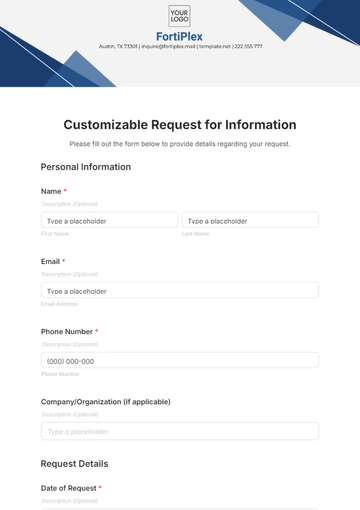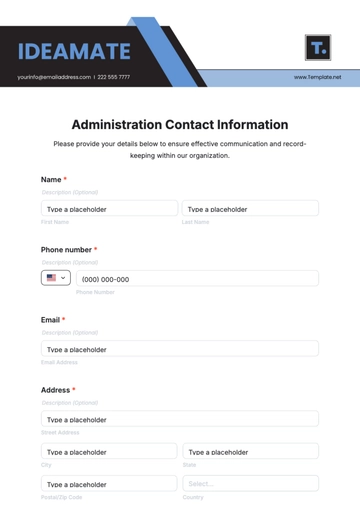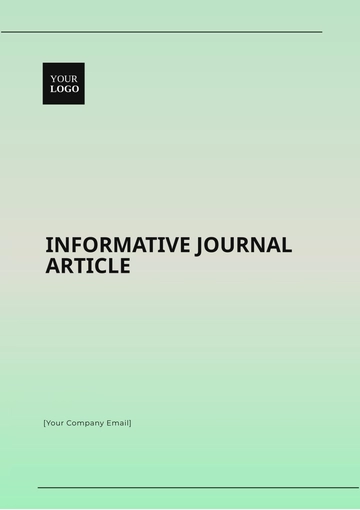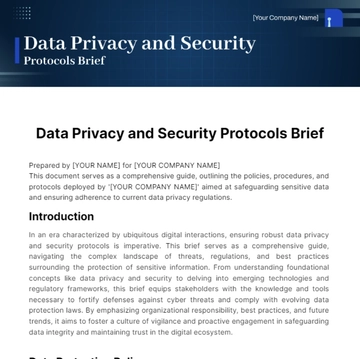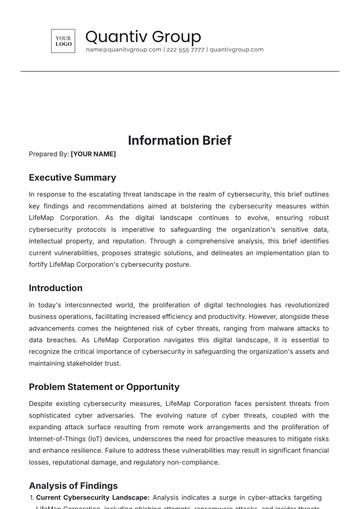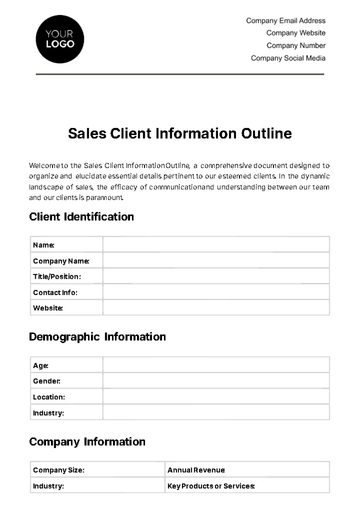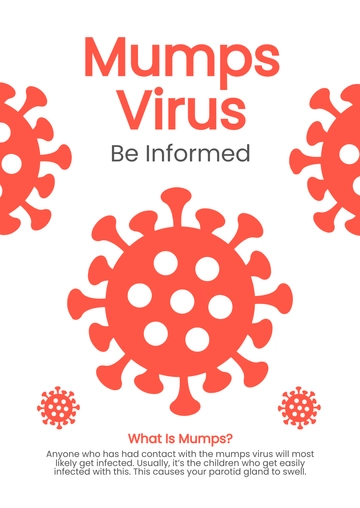Free Information Brief
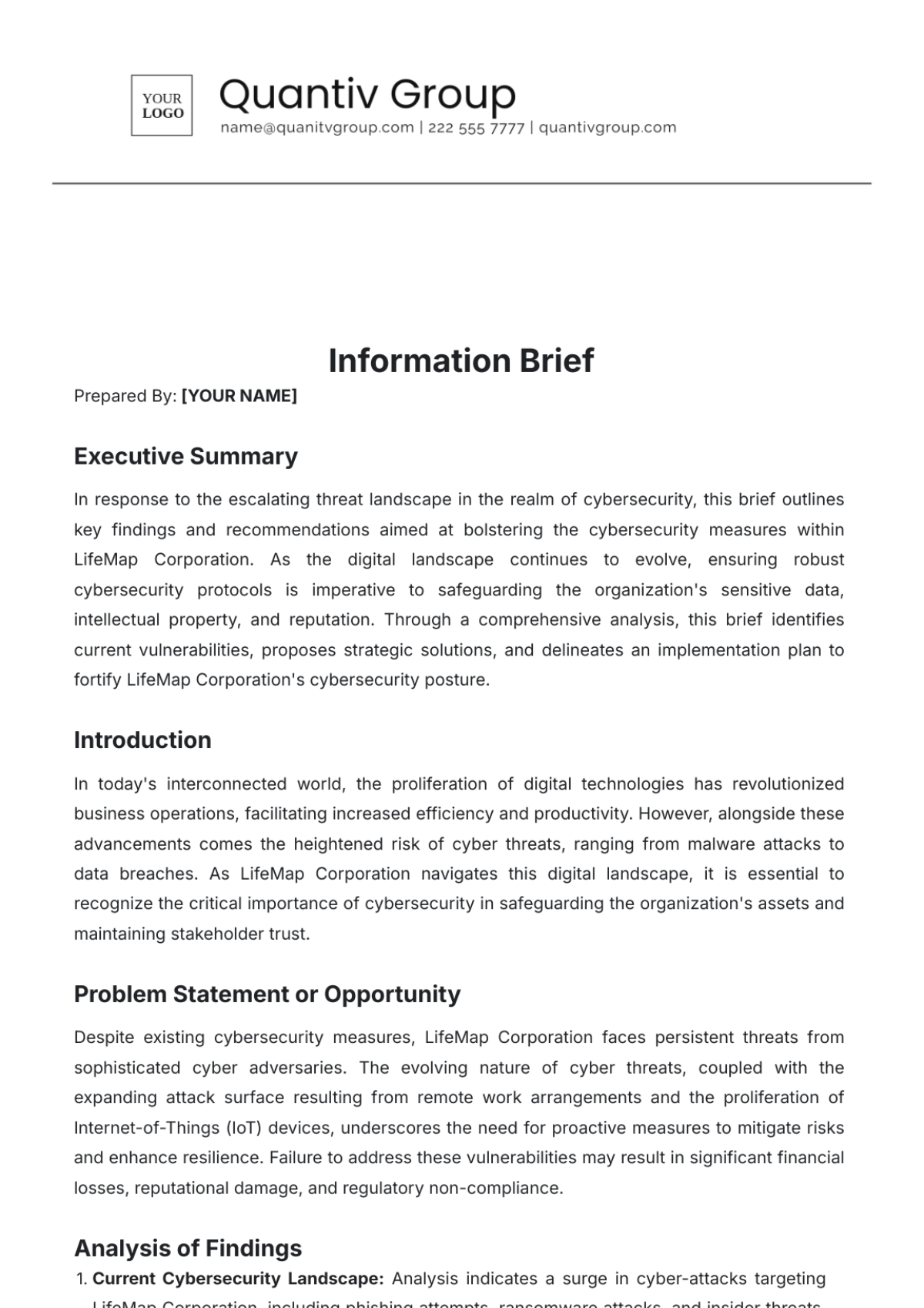
Prepared By: [YOUR NAME]
Executive Summary
In response to the escalating threat landscape in the realm of cybersecurity, this brief outlines key findings and recommendations aimed at bolstering the cybersecurity measures within LifeMap Corporation. As the digital landscape continues to evolve, ensuring robust cybersecurity protocols is imperative to safeguarding the organization's sensitive data, intellectual property, and reputation. Through a comprehensive analysis, this brief identifies current vulnerabilities, proposes strategic solutions, and delineates an implementation plan to fortify LifeMap Corporation's cybersecurity posture.
Introduction
In today's interconnected world, the proliferation of digital technologies has revolutionized business operations, facilitating increased efficiency and productivity. However, alongside these advancements comes the heightened risk of cyber threats, ranging from malware attacks to data breaches. As LifeMap Corporation navigates this digital landscape, it is essential to recognize the critical importance of cybersecurity in safeguarding the organization's assets and maintaining stakeholder trust.
Problem Statement or Opportunity
Despite existing cybersecurity measures, LifeMap Corporation faces persistent threats from sophisticated cyber adversaries. The evolving nature of cyber threats, coupled with the expanding attack surface resulting from remote work arrangements and the proliferation of Internet-of-Things (IoT) devices, underscores the need for proactive measures to mitigate risks and enhance resilience. Failure to address these vulnerabilities may result in significant financial losses, reputational damage, and regulatory non-compliance.
Analysis of Findings
Current Cybersecurity Landscape: Analysis indicates a surge in cyber-attacks targeting LifeMap Corporation, including phishing attempts, ransomware attacks, and insider threats. These incidents highlight the inadequacies of existing security measures in mitigating emerging threats effectively.
Vulnerability Assessment: A comprehensive assessment reveals critical vulnerabilities within LifeMap Corporation's network infrastructure, software systems, and employee cybersecurity awareness. Weaknesses in patch management, access control mechanisms, and incident response protocols pose significant risks to the organization's data integrity and confidentiality.
Regulatory Compliance: Non-compliance with industry-specific regulations, such as GDPR and HIPAA, poses legal ramifications and potential financial penalties for LifeMap Corporation. Ensuring adherence to regulatory requirements is paramount to maintaining operational continuity and avoiding legal liabilities.
Human Factor: Employee negligence and lack of cybersecurity training contribute to the susceptibility of LifeMap Corporation to social engineering attacks and insider threats. Addressing the human factor through comprehensive training programs and awareness initiatives is essential to fostering a culture of cybersecurity awareness and responsibility.
Recommendations
Enhanced Endpoint Security: Deploy advanced endpoint protection solutions, including next-generation antivirus software and endpoint detection and response (EDR) systems, to mitigate malware threats and unauthorized access attempts.
Improved Access Controls: Implement robust access control mechanisms, such as multi-factor authentication (MFA) and role-based access controls (RBAC), to restrict unauthorized access to sensitive data and systems.
Regular Vulnerability Assessments and Penetration Testing: Conduct periodic vulnerability assessments and penetration testing to identify and remediate security weaknesses proactively.
Cybersecurity Training and Awareness Programs: Develop and implement comprehensive cybersecurity training programs to educate employees about potential threats, best practices for securely handling data, and incident response protocols.
Implementation Plan
Phase 1: Assessment and Planning
Conduct a comprehensive cybersecurity risk assessment to identify vulnerabilities and prioritize remediation efforts.
Develop a detailed implementation plan outlining specific objectives, timelines, and resource allocations.
Phase 2: Deployment of Security Solutions
Procure and deploy advanced cybersecurity solutions, including endpoint security software, intrusion detection systems (IDS), and security information and event management (SIEM) solutions.
Phase 3: Employee Training and Awareness
Roll out cybersecurity training programs for all employees, emphasizing the importance of cybersecurity best practices and incident reporting procedures.
Phase 4: Continuous Monitoring and Improvement
Implement regular security audits and penetration testing exercises to assess the effectiveness of security controls.
Continuously update and refine cybersecurity policies and procedures in response to evolving threats and regulatory requirements.
Conclusion
In conclusion, the ever-evolving threat landscape necessitates a proactive approach to cybersecurity within LifeMap Corporation. By implementing the recommended measures outlined in this brief, the organization can bolster its resilience against cyber threats, safeguard sensitive data, and uphold stakeholder trust. Embracing a culture of cybersecurity awareness and investing in robust security solutions are essential steps toward ensuring the long-term viability and success of LifeMap Corporation in an increasingly digital world.
- 100% Customizable, free editor
- Access 1 Million+ Templates, photo’s & graphics
- Download or share as a template
- Click and replace photos, graphics, text, backgrounds
- Resize, crop, AI write & more
- Access advanced editor
Introducing the Information Brief Template from Template.net – your comprehensive solution for organized data presentation. This editable and customizable template allows effortless tailoring to your specific needs. With intuitive editing options available in our Ai Editor Tool, every detail is easily adjustable to suit your preferences. Streamline your information management process and enhance clarity with this versatile tool.

